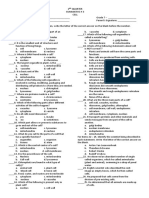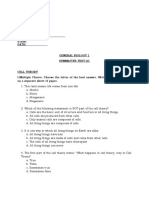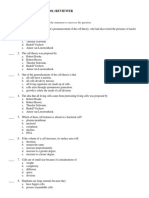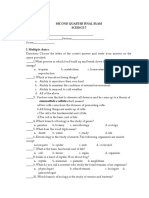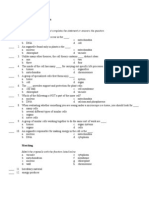0 ratings0% found this document useful (0 votes)
11 viewsBiotech Q1summative
Biotech Q1summative
Uploaded by
Jeralyn Vallecer-AbelloThis document contains a 20 question summative test on biotechnology and cell biology. The test assesses knowledge of key cellular structures and their functions, including the nucleus, DNA, ribosomes, mitochondria, chloroplasts, cell membrane, and cell wall. It also covers cellular processes like diffusion and the early scientists who pioneered the field including Van Leeuwenhoek, Hooke, Remak, Schleiden, and Schwann. The second part labels diagrams of animal and plant cells.
Copyright:
© All Rights Reserved
Available Formats
Download as DOCX, PDF, TXT or read online from Scribd
Biotech Q1summative
Biotech Q1summative
Uploaded by
Jeralyn Vallecer-Abello0 ratings0% found this document useful (0 votes)
11 views2 pagesThis document contains a 20 question summative test on biotechnology and cell biology. The test assesses knowledge of key cellular structures and their functions, including the nucleus, DNA, ribosomes, mitochondria, chloroplasts, cell membrane, and cell wall. It also covers cellular processes like diffusion and the early scientists who pioneered the field including Van Leeuwenhoek, Hooke, Remak, Schleiden, and Schwann. The second part labels diagrams of animal and plant cells.
Original Title
biotech.q1summative
Copyright
© © All Rights Reserved
Available Formats
DOCX, PDF, TXT or read online from Scribd
Share this document
Did you find this document useful?
Is this content inappropriate?
This document contains a 20 question summative test on biotechnology and cell biology. The test assesses knowledge of key cellular structures and their functions, including the nucleus, DNA, ribosomes, mitochondria, chloroplasts, cell membrane, and cell wall. It also covers cellular processes like diffusion and the early scientists who pioneered the field including Van Leeuwenhoek, Hooke, Remak, Schleiden, and Schwann. The second part labels diagrams of animal and plant cells.
Copyright:
© All Rights Reserved
Available Formats
Download as DOCX, PDF, TXT or read online from Scribd
Download as docx, pdf, or txt
0 ratings0% found this document useful (0 votes)
11 views2 pagesBiotech Q1summative
Biotech Q1summative
Uploaded by
Jeralyn Vallecer-AbelloThis document contains a 20 question summative test on biotechnology and cell biology. The test assesses knowledge of key cellular structures and their functions, including the nucleus, DNA, ribosomes, mitochondria, chloroplasts, cell membrane, and cell wall. It also covers cellular processes like diffusion and the early scientists who pioneered the field including Van Leeuwenhoek, Hooke, Remak, Schleiden, and Schwann. The second part labels diagrams of animal and plant cells.
Copyright:
© All Rights Reserved
Available Formats
Download as DOCX, PDF, TXT or read online from Scribd
Download as docx, pdf, or txt
You are on page 1of 2
BIOTECHNOLOGY
Summative Test Q1
Name: ________________________ Grade/Section: DNA Date: Oct. 20, 2023 Score:
Directions: Choose the letter of the best answer. Write the chosen letter on the space provided.
____ 1. The smallest, basic unit of life that is responsible for all of life's processes.
a. ATP b. DNA c. Ribosome d. Cell
____ 2. Which of the following organelles is responsible for protein production.
a. Ribosomes b. Nucleus c. Lysosome d. Mitochondria
____ 3. Is the molecule that carries genetic information for the development and functioning of an organism.
a. ATP b. DNA c. Ribosome d. Cell
____ 4. Organisms whose cells do not have nucleus is called_________.
a. Eukaryotes b. Organelles c. Plants d. Prokaryotes
____ 5. Present in the rough ER and synthesizes protein.
a. Chloroplast b. Golgi complex c. Lysosome d. Ribosomes
____ 6. In which of the following items would you expect to find cells?
a. Eyeglasses b. Plastic Flower c. A peso coin d. Strawberry
____ 7. Which of the following is the function of cell membrane?
A. Keeps the cell wall in place.
B. Stores water, salt, proteins, and carbohydrates.
C. Breaks down lipids, carbohydrates, and proteins from foods.
D. Regulates the movement of materials into and out of the cell.
____ 8. The control center which contain DNA.
a. Ribosomes b. Nucleus c. Lysosome d. Mitochondria
____ 9. The organelle which process energy for the cell.
a. Ribosomes b. Nucleus c. Lysosome d. Mitochondria
____ 10. What type of cell has these characteristics: contain DNA but no nucleus, contains flagella, ribosomes,
cytoplasm and plasma membrane.
a. Animal b. Bacteria c. Fungi d. Plant
____ 11. Breaks down materials for digestion and contains enzymes for cell.
a. Chloroplast b. Golgi complex c. Lysosome d. Ribosomes
____ 12. Found only in plants, it protects and maintains shape of the cell.
a. Cytoplasm b. Cell membrane c. Cell wall d. Capsule
____ 13. He found the nucleus inside the cell. He coined the term “nucleus”.
a. Anton Van Leeuwenhoek c. Zacharias Janssen
b. Robert Hooke d. Robert Brown
____ 14. He invented the first microscope together with his father.
a. Anton Van Leeuwenhoek c. Zacharias Janssen
b. Robert Hooke d. Robert Brown
____ 15. It is the gelatinous liquid that fills the inside of a cell.
a. Cytoplasm b. Cell membrane c. Smooth ER d. Rough ER
____ 16. A botanist concluded through his observations that all plants are made up cells
a. Robert Hooke b. Robert Remak c. Matthias Schleiden d. Theodor Schwann
____ 17. He discovered cell division and confirms existence of plasma membrane.
a. Robert Hooke b. Robert Remak c. Matthias Schleiden d. Theodor Schwann
____ 18. . He looked into his own dental craping and found tiny motile objects. He called them “animalcules”.
a. Anton Van Leeuwenhoek b. Robert Hooke c. Zacharias Janssen d. Robert Brown
____ 19. What causes diffusion?
A. Molecules are attracted to one another.
B. Molecules constantly move and collide with each other.
C. Cellular energy forces molecules to collide with each other.
D. Cellular energy pumps molecules across the cell membrane
____ 20. Which of the following structures serves as the cell’s boundary from its environment?
A. Cell membrane B. Chloroplast C. Mitochondria D. Ribosomes
Part II. Label the parts.
Animal Cell
1.
2.
3.
4.
5.
(dots) 6.
7.
8.
Plant Cell
9.
10
You might also like
- Earth & Life 2nd Quarter Exam 2019-2020Document5 pagesEarth & Life 2nd Quarter Exam 2019-2020argie joy marie0% (1)
- Biology - EXTRA - Minka Peeters - Fourth Edition - IBID 2014Document228 pagesBiology - EXTRA - Minka Peeters - Fourth Edition - IBID 2014AnuradhaNo ratings yet
- Written Work 1 CellDocument5 pagesWritten Work 1 CellAnna Liza CarrascalNo ratings yet
- OralDocument3 pagesOralSolemn NichiNo ratings yet
- 1ST Quarter Exam in General Biology 1Document3 pages1ST Quarter Exam in General Biology 1KatherineNo ratings yet
- Activity Sheet - CellDocument2 pagesActivity Sheet - CellBettina Sanchez100% (1)
- 2nd QT Summative Test 3 CELLDocument1 page2nd QT Summative Test 3 CELLRowena Sta MariaNo ratings yet
- Chapter 7 Test Bank: Multiple ChoiceDocument22 pagesChapter 7 Test Bank: Multiple ChoicePayal100% (1)
- Kami Export - MARC LOUIS - Biology Test Cell StructureDocument6 pagesKami Export - MARC LOUIS - Biology Test Cell StructureMarc LouisNo ratings yet
- Table of Specification in 1GEN BIO 1STDocument3 pagesTable of Specification in 1GEN BIO 1STLouie DenostaNo ratings yet
- I. Multiple Choice. Choose The Letter of The Best AnswerDocument3 pagesI. Multiple Choice. Choose The Letter of The Best AnswerKeannoNo ratings yet
- Summative Test Genbio 1 Q1Document26 pagesSummative Test Genbio 1 Q1Duane0% (1)
- BIO Ch7 STUDY GUIDEDocument7 pagesBIO Ch7 STUDY GUIDETychi WangNo ratings yet
- General Biology 1 (BIO01) Reviewer 2017Document30 pagesGeneral Biology 1 (BIO01) Reviewer 2017Adonis AdornadoNo ratings yet
- Questionnaire in Science 2Document4 pagesQuestionnaire in Science 2Rebecca CaponongNo ratings yet
- M1 Science Test-Cells: Multiple ChoiceDocument5 pagesM1 Science Test-Cells: Multiple ChoiceBillD100% (1)
- Cell Organelles Quiz 2Document3 pagesCell Organelles Quiz 2ellie.foxhoven26No ratings yet
- Msu Marantao MidtermDocument3 pagesMsu Marantao MidtermRaihana YusophNo ratings yet
- Biology Test Cell StructureDocument7 pagesBiology Test Cell Structuredee.aira295550% (2)
- General Biology 1 2023 ExamDocument22 pagesGeneral Biology 1 2023 Examrolly baloNo ratings yet
- Cell QuizDocument9 pagesCell QuizAhdzorizm Plcn100% (1)
- science 7Document3 pagesscience 7ariany.batonghinogNo ratings yet
- Cells Practice TestDocument2 pagesCells Practice TestlangayandawnyNo ratings yet
- Summative Science 7-2ndquarterDocument3 pagesSummative Science 7-2ndquarterNinel Jean Cantera Buniel100% (1)
- Grade 7STE Science 2nd QuarterDocument7 pagesGrade 7STE Science 2nd Quarterjovdoctolero15No ratings yet
- 1ST UNIT EXAM Gen Bio 1key AnswerDocument4 pages1ST UNIT EXAM Gen Bio 1key AnswerMea-Ann OscianasNo ratings yet
- General Biology 1 Stem 12: Test L. Multiple Choice. Encircle The Letter of The Correct AnswerDocument3 pagesGeneral Biology 1 Stem 12: Test L. Multiple Choice. Encircle The Letter of The Correct AnswerJohnson FernandezNo ratings yet
- Biology CH 7 Practice TestDocument6 pagesBiology CH 7 Practice Testvaleria100% (2)
- q2m9 - QuizDocument4 pagesq2m9 - QuizVannie MonderoNo ratings yet
- Midterm in Science 7Document3 pagesMidterm in Science 7Raihana YusophNo ratings yet
- Ncert and Exemplar Solutions CellDocument9 pagesNcert and Exemplar Solutions CellrishabhlikespizzaNo ratings yet
- General Biology Midterm Examination: Senior High School Department Academic Year 2021-2022Document3 pagesGeneral Biology Midterm Examination: Senior High School Department Academic Year 2021-2022Ronald ValenzuelaNo ratings yet
- Test-Cells & Organelles v.2Document3 pagesTest-Cells & Organelles v.2litiffany866No ratings yet
- Text 15Document3 pagesText 15Julia SchimpffNo ratings yet
- ANSWER KEY - Quarter Exam BiologyDocument3 pagesANSWER KEY - Quarter Exam BiologySteph LaguitanNo ratings yet
- Introduction To Biochemistry Name: - Date: - Course & Year: - ScoreDocument3 pagesIntroduction To Biochemistry Name: - Date: - Course & Year: - ScoreCzarina Mae Quinones TadeoNo ratings yet
- 2ND Finals EARTHSCIDocument3 pages2ND Finals EARTHSCIIris LeuterioNo ratings yet
- Final Grade 7 - Unit Test 1 - 1st SemDocument9 pagesFinal Grade 7 - Unit Test 1 - 1st Semfroilan obligadoNo ratings yet
- SCIENCE 7 2nd MidtermDocument2 pagesSCIENCE 7 2nd Midtermjuliusvaldez07201996No ratings yet
- SCIENCE 7 and 8 Quarterly EXAMDocument9 pagesSCIENCE 7 and 8 Quarterly EXAMSarah Jane CasipongNo ratings yet
- Gayong-Gayong Sur Integrated School Second Periodic Examination in Science 7 Name: - Date: - ScoreDocument3 pagesGayong-Gayong Sur Integrated School Second Periodic Examination in Science 7 Name: - Date: - ScoreLaira Joy Salvador - ViernesNo ratings yet
- Science7 - FinalDocument5 pagesScience7 - FinalJeanifer CabusogNo ratings yet
- Biology M2 Cell Structure & Function PDFDocument24 pagesBiology M2 Cell Structure & Function PDFAICKEN N. SAGANo ratings yet
- 2 Quarter Examination S.Y. 2019-2020: Earth Life and Science - Grade 11Document6 pages2 Quarter Examination S.Y. 2019-2020: Earth Life and Science - Grade 11Mihatsu Taki100% (1)
- UntitledDocument2 pagesUntitledEDWIN DUMOPOYNo ratings yet
- Semi QuarterDocument3 pagesSemi QuarterShaikha Rose A. CacabilosNo ratings yet
- This Test in One HourDocument6 pagesThis Test in One HourMara M. LabanderoNo ratings yet
- C. LysosomesDocument4 pagesC. Lysosomesabbod70885861No ratings yet
- Activity 3 Gen - Bio MaryjoiceDocument3 pagesActivity 3 Gen - Bio MaryjoiceKei SantiagoNo ratings yet
- Class 6 Cell Organelles - QuizizzDocument8 pagesClass 6 Cell Organelles - QuizizzNeha SaneyNo ratings yet
- Midterm Examination in BIOLOGY I. Multiple ChoiceDocument6 pagesMidterm Examination in BIOLOGY I. Multiple ChoiceMa.Janice GarciaNo ratings yet
- Ease 2 Biology Grade 7 2020 2021 FinalDocument14 pagesEase 2 Biology Grade 7 2020 2021 FinalfajarNo ratings yet
- UntitledDocument3 pagesUntitledEDWIN DUMOPOYNo ratings yet
- VIBAR, Justine - Biochem LE 1&2Document3 pagesVIBAR, Justine - Biochem LE 1&2JustineNo ratings yet
- 2ND PTE ReviewerDocument2 pages2ND PTE ReviewerSumire KakeiNo ratings yet
- Multiple ChoiceDocument19 pagesMultiple ChoiceJoke JoNo ratings yet
- Grade 9 V2Document3 pagesGrade 9 V2hanatabbal19No ratings yet
- 2nd Periodical Examination in Science 7Document3 pages2nd Periodical Examination in Science 7Kaye Ochigue Galope-ObsidNo ratings yet
- 2nd QRTR ExamDocument3 pages2nd QRTR ExamAlexander AlcazarinNo ratings yet
- Cell BiologyDocument8 pagesCell BiologySharad DahalNo ratings yet
- O Level Biology Practice Questions And Answers CellsFrom EverandO Level Biology Practice Questions And Answers CellsRating: 5 out of 5 stars5/5 (2)
- Test - IB Biology 5.2 - QuizletDocument2 pagesTest - IB Biology 5.2 - QuizletSumi VjNo ratings yet
- Group Selection - WikipediaDocument22 pagesGroup Selection - WikipediaOzhenNo ratings yet
- Pengenalan Teknologi Kloning Melalui Media Pembelajaran Interaktif "Lakon" Pada Siswa SMA Di Kota YogyakartaDocument10 pagesPengenalan Teknologi Kloning Melalui Media Pembelajaran Interaktif "Lakon" Pada Siswa SMA Di Kota YogyakartaYaumil MuthahharaNo ratings yet
- Section 5 QuizDocument2 pagesSection 5 QuizRizki Rian AnugrahaniNo ratings yet
- One Gene One Enzyme TheoryDocument16 pagesOne Gene One Enzyme TheoryMuhammad ZakriaNo ratings yet
- AziyatDocument7 pagesAziyatASHFAQ AHMADNo ratings yet
- AryanDocument22 pagesAryanHarshit MishraNo ratings yet
- 5.0 Various PCRDocument34 pages5.0 Various PCRvivian kiuNo ratings yet
- Tomatoes Tamed Again With CRISPR: Gene Editing Opens The Way To Healthier Crops, FindsDocument1 pageTomatoes Tamed Again With CRISPR: Gene Editing Opens The Way To Healthier Crops, FindsHan YiNo ratings yet
- NMAT Biology Practice TestDocument1 pageNMAT Biology Practice TestSheriffCaitlynNo ratings yet
- Cambridge IGCSE: AGRICULTURE 0600/12Document24 pagesCambridge IGCSE: AGRICULTURE 0600/12For GamingNo ratings yet
- CorynebacteriumDocument14 pagesCorynebacteriumGerrard Angelo CastillaNo ratings yet
- The Nucleus (Methods in Molecular Biology Ed 3Document221 pagesThe Nucleus (Methods in Molecular Biology Ed 3Adolfo López100% (1)
- Enumeration of Probiotic Strains PDFDocument9 pagesEnumeration of Probiotic Strains PDFYamunaa ElencovanNo ratings yet
- Jawapan Topikal Kertas 1 Tingkatan 5Document14 pagesJawapan Topikal Kertas 1 Tingkatan 5cikguchris82No ratings yet
- Grand Challenges in Biology EducationDocument16 pagesGrand Challenges in Biology EducationFrancêsco LopesNo ratings yet
- Class 12 BIOLOGY 2024-2025Document3 pagesClass 12 BIOLOGY 2024-2025yukikanna2007No ratings yet
- Cell Aggregation and Differentiation in DICTYOSTELIUMDocument41 pagesCell Aggregation and Differentiation in DICTYOSTELIUMVANSHIKANo ratings yet
- PDF TextDocument2 pagesPDF TextsathibhajanNo ratings yet
- Module 1-Zoology - HistoryDocument51 pagesModule 1-Zoology - HistoryVincent Miguel BastieroNo ratings yet
- Factors Affecting Mental HealthDocument32 pagesFactors Affecting Mental HealthJeric QueroNo ratings yet
- Planaria Lab Report 1Document4 pagesPlanaria Lab Report 1api-194762478No ratings yet
- Hybrid Seed Production and Breeding Methods in Chilli: Capsicum AnnuumDocument11 pagesHybrid Seed Production and Breeding Methods in Chilli: Capsicum AnnuumShalin Mano100% (1)
- BFIS - Bullying and Friendship Interview ScheduleDocument2 pagesBFIS - Bullying and Friendship Interview ScheduleMaría Luisa Torrejón Llanos100% (1)
- Finale Lesson PlanDocument11 pagesFinale Lesson PlanJayson SorianoNo ratings yet
- Plant Cell LabelDocument1 pagePlant Cell LabelAllen TagatacNo ratings yet
- Faculty of Psychology Bachelor of Science (Psychology) Curriculum Structure Document Academic YearDocument97 pagesFaculty of Psychology Bachelor of Science (Psychology) Curriculum Structure Document Academic YearKashyapi thakuriaNo ratings yet
- Student Exploration - Natural Selection1Document5 pagesStudent Exploration - Natural Selection1Maaz MinhasNo ratings yet
- Genomics & ProteomicsDocument1 pageGenomics & ProteomicsVanshika SharmaNo ratings yet






